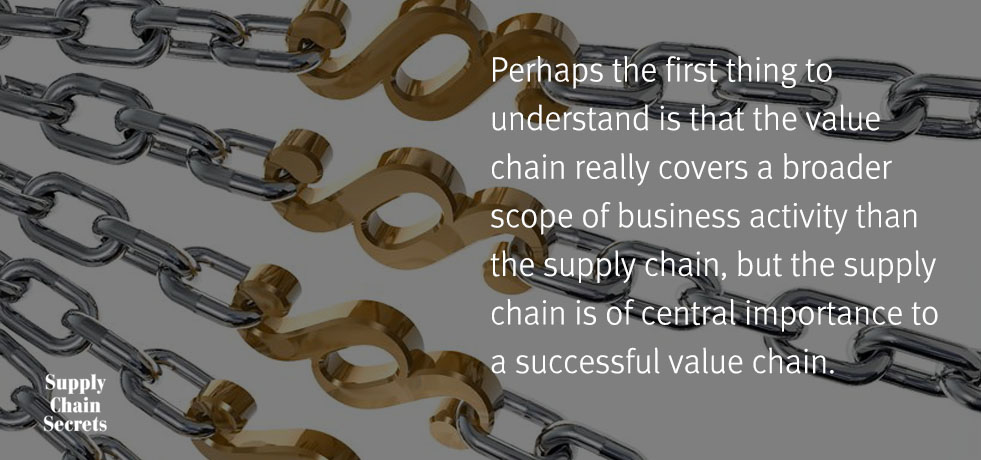You may have heard the term “value chain” being used among supply chain professionals and wondered if it’s just a trendy alternative label, or if there is some difference between value chain and supply chain.
Are they one and the same? Are they different?
The answer unfortunately is “both”, which of course is not exactly helpful.
In this post then, I’d like to clarify the similarities and differences between the supply chain and the value chain without diving into too much detail.
The idea is to give you food for thought and to encourage you to explore the value chain topic further, since it is important not only to the supply chain, but also to the overall success of just about any business operating today.
A Brief Explanation of the Value Chain
The definition and description of the supply chain has been covered elsewhere on this blog, so I’ll focus here on clarifying the meaning of the “value chain“.
Essentially, the value chain comprises all business activities which increase the value of a product or service in the eyes of the buyer. It follows then, that the value chain tends to be traced in the opposite direction to the supply chain.
The value chain flows from the customer, back through the supply chain to the production/creation/extraction of raw materials, but also includes activities you wouldn’t typically associate with the supply chain—activities such as product development and marketing.
Value Chain Thinking in the Supply Chain
The reason we tend to associate the supply chain with the value chain is because ultimately, supply chain activities, such as inbound logistics, manufacture/production, and outbound logistics, offer many direct opportunities to add value for customers/consumers.
Innovative enterprises have learned that if it’s to be utilised for competitive advantage, the supply chain must be viewed not as a necessary cost of providing a product or service, but as a source of extra value and hence, profit.
This shift toward value-chain thinking has led businesses to focus less on cost reduction in the supply chain and instead, to seek ways to leverage value-adding opportunities. As an illustration of how this might work, I’ll conclude with a few examples of how supply chain components enhance the value of a product or service:
Inbound Logistics
Basic Value: Enables production or manufacture, by ensuring component products or materials are available.
Extra value might be generated by your raw material suppliers, for example, by managing your raw material inventory on your behalf.
Manufacturing/Production Operations
Basic Value: Creates a product that can be marketed and sold to meet the needs or desires of customers.
Extra value can be created by improving quality control, building additional features into a product, or offering customised manufacture.
Outbound Logistics
Basic Value: Places your products or services in the exact location required by your customers.
Extra value might be added if you deliver your products or services to a consumer’s home or business, instead of a retail store or service centre.
Other examples of value addition in outbound logistics might include:
- Removal of a customer’s old product upon delivery of the new one
- Placing finished goods on the shelves of a retail store instead of on the unloading dock
- Reducing the time taken to deliver a product or service to your customer.
The Value of Value Chain Knowledge
Value chain thinking is here to stay, and will apply increasingly to the supply chain as companies continue to focus less on cost reduction and more on innovation.
The more you know about the value chain, the better you will be able to identify value and exploit it in your employer’s business, or your own (if you are a business owner/leader).
You can find out more about value chain thinking and other aspects of supply chain strategy in What is Supply Chain Management?
Offered at the great price of $47 (UD), my beginner’s guide to concepts and terminology used in today’s supply chains comes with a package of complementary bonus items to help you grow your supply chain knowledge. Just to add even more value, What is Supply Chain Management? also comes with a 60-day, 100% refund policy, so why not download your copy, risk-free, today?


